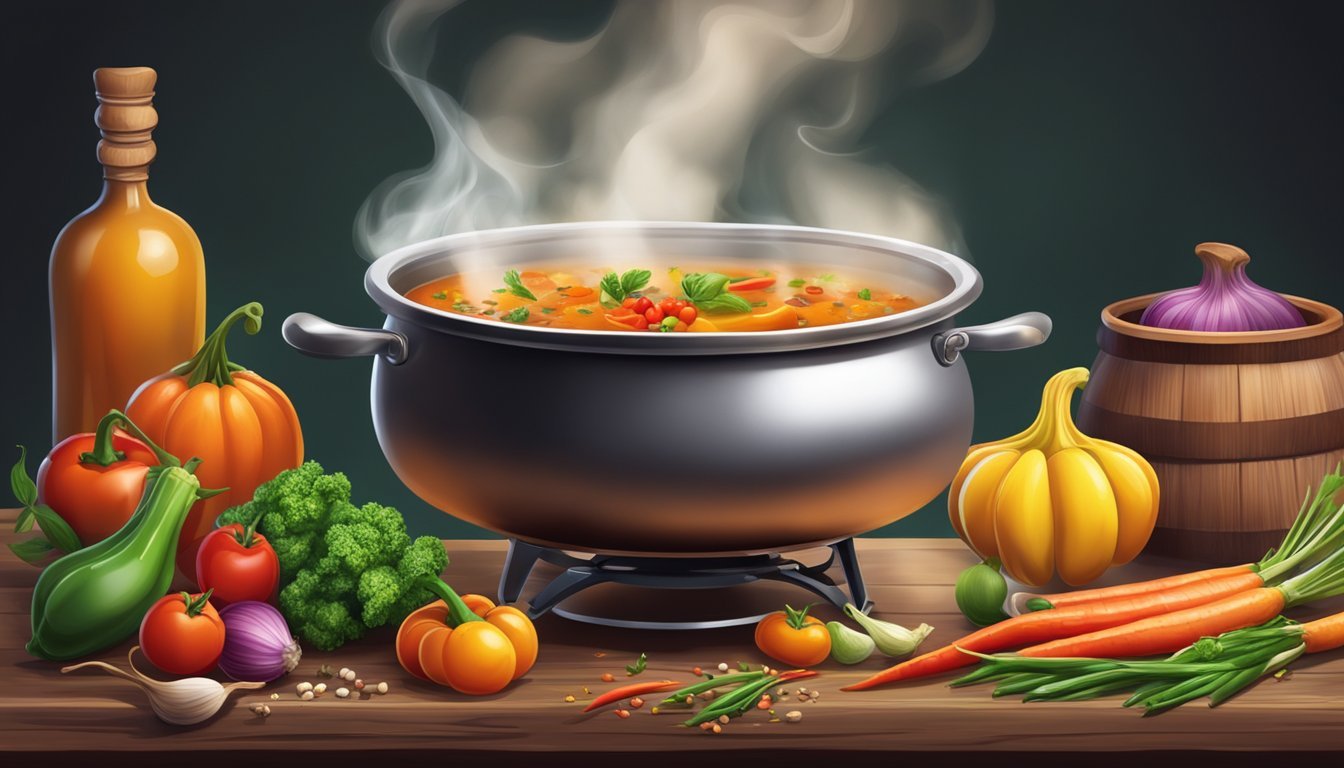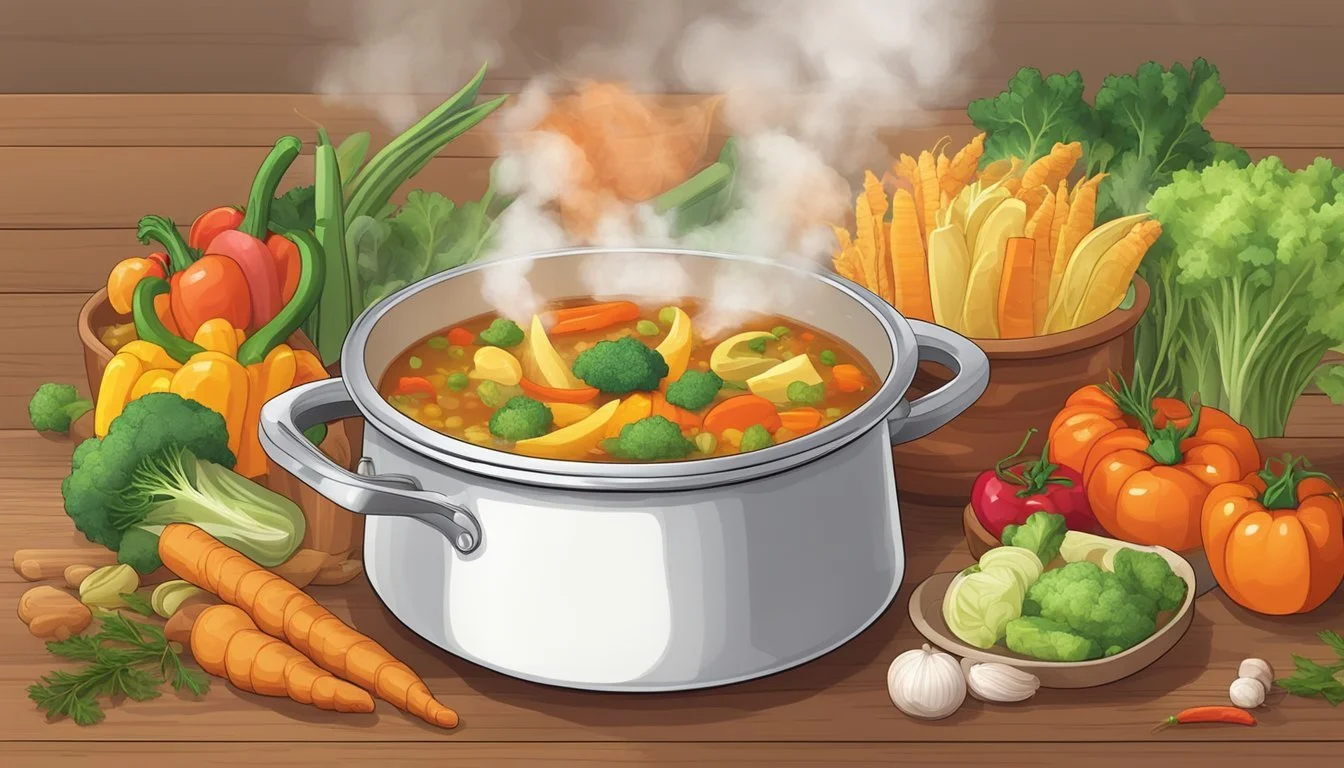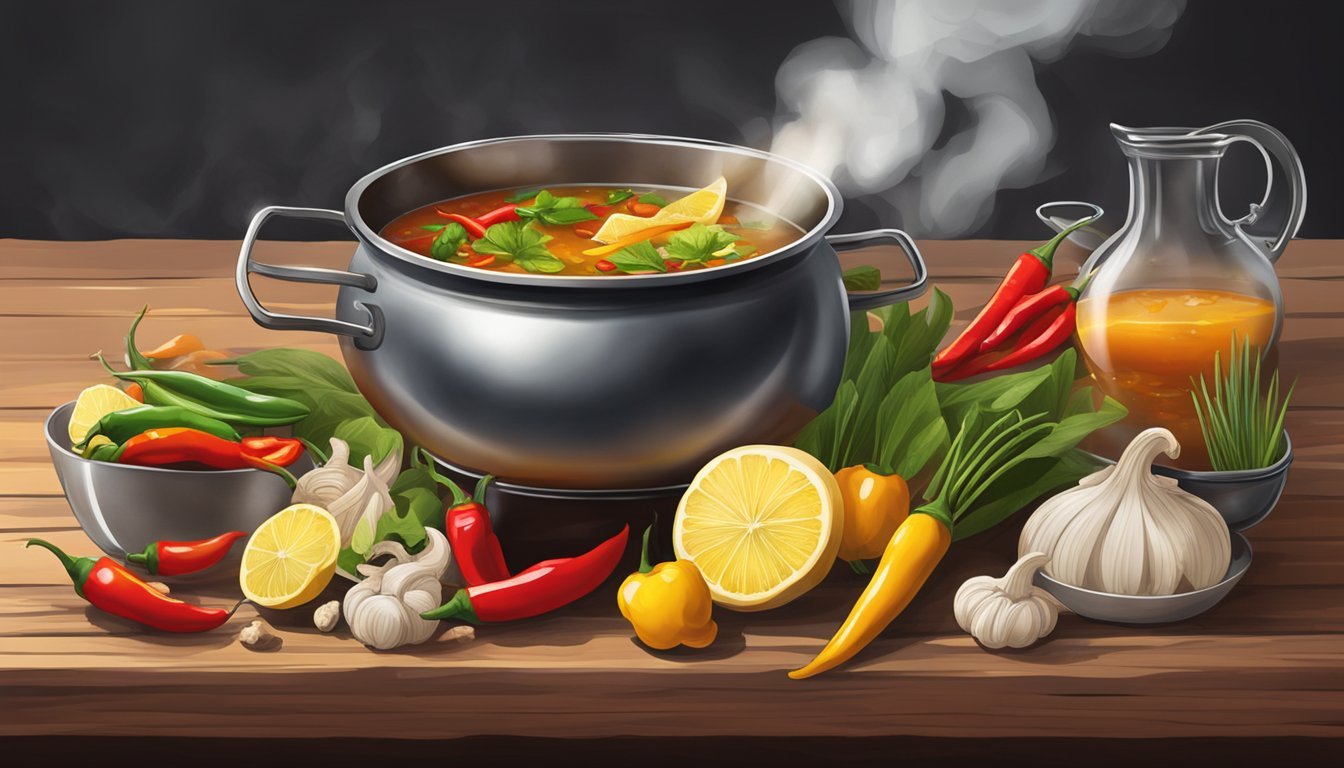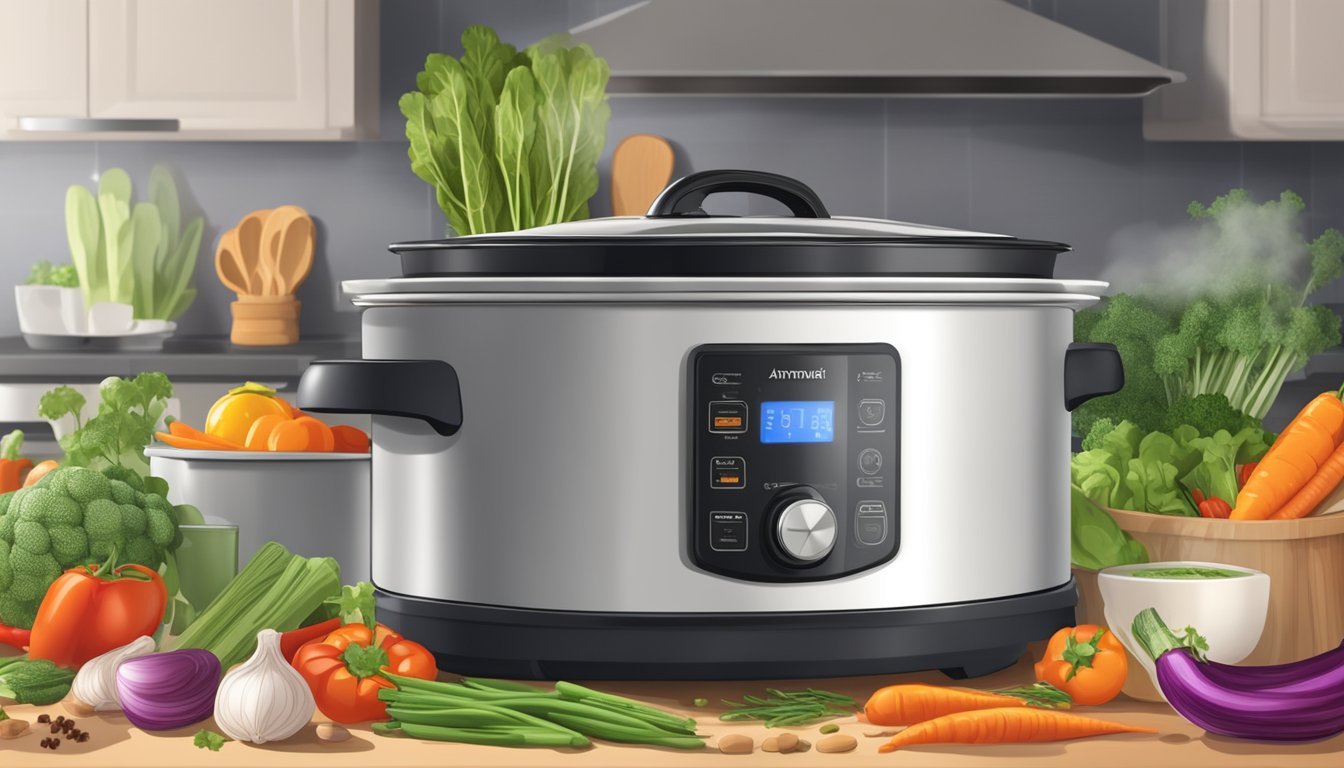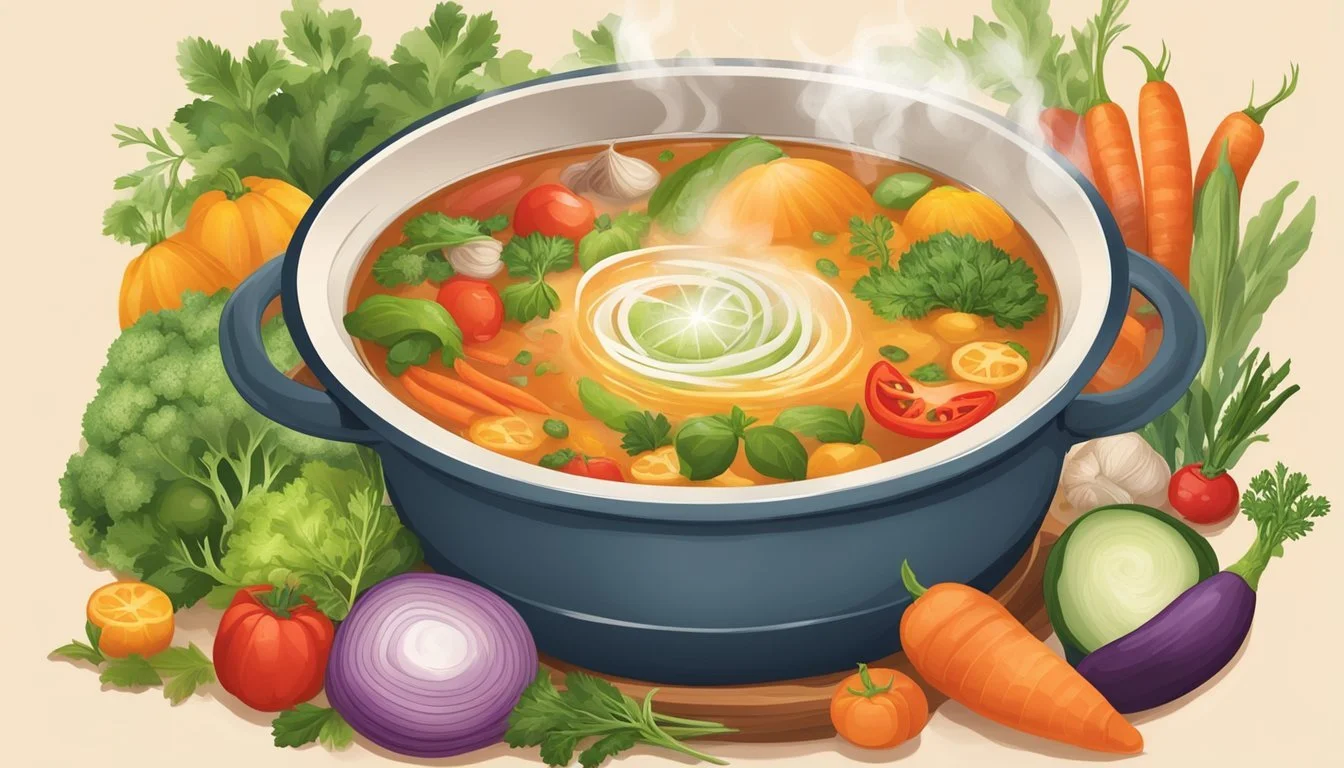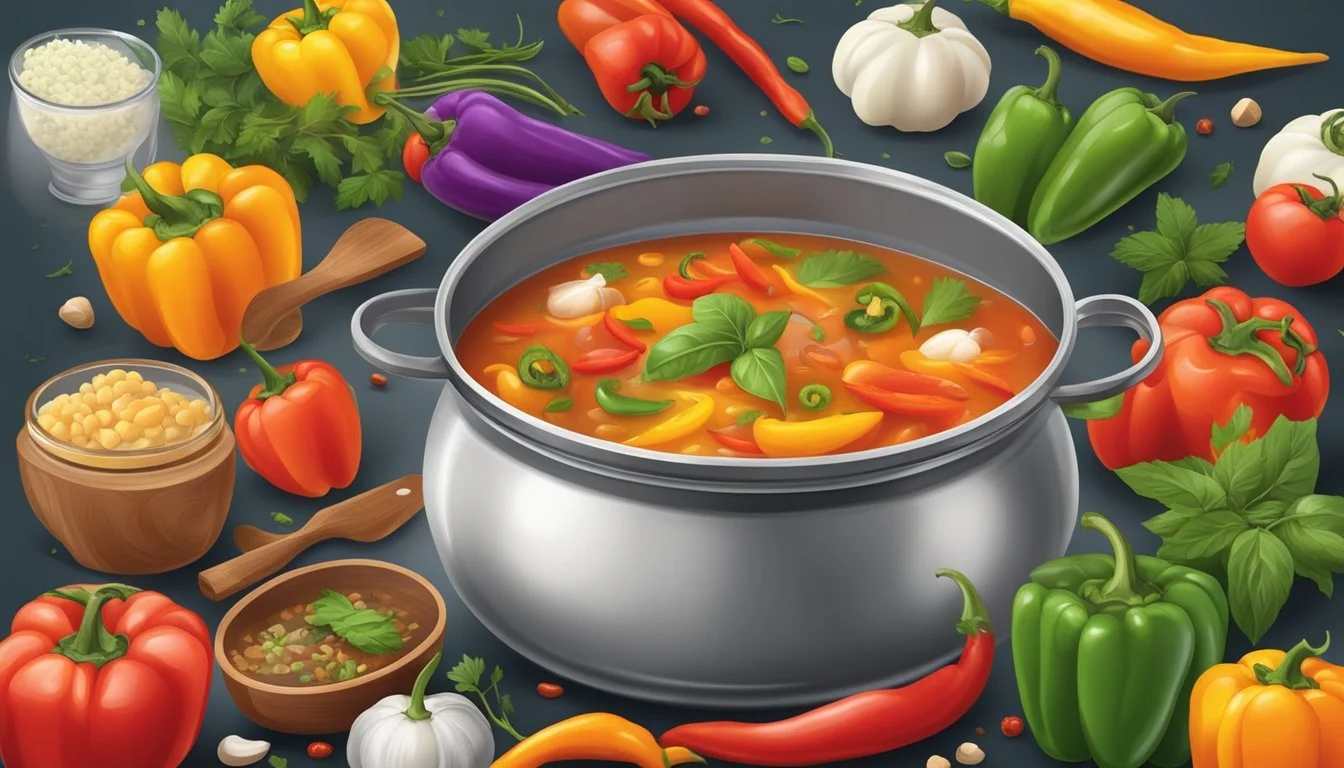Swicy Soups and Stews
Recipes to Ignite Your Palate with Heat and Sweetness
As the culinary landscape evolves, the integration of contrasting flavors has become a staple among innovative chefs and home cooks alike. 'Swicy,' a portmanteau representing the harmonious blend of sweet and spicy elements, exemplifies this trend well. These flavor profiles are increasingly prominent in soups (What wine goes well with soups?) and stews (What wine goes well with stews?), offering a multi-dimensional palate experience that has captured the attention of food enthusiasts. Favoring this combination is not solely about the pursuit of new taste sensations; it also reflects a growing understanding of how sweetness can temper the heat of spices, resulting in dishes that are rich, complex, and satisfying.
In the realm of comfort food, swicy soups and stews stand out, particularly during colder months when the body craves warmth and substance. The allure of swicy recipes lies in their ability to both soothe and excite, offering a cozy yet zesty approach to traditional comfort food. They encapsulate the essence of home-cooked nourishment while introducing an element of surprise through their vibrant flavor profiles. This interplay of sweetness with a kick of heat not only enhances the taste but can also stimulate a sense of well-being by inducing the release of endorphins, heightening the dining experience.
As these swicy dishes gain popularity, they are becoming fixtures in restaurant menus and kitchen repertoires, reflecting their broad appeal. From the gentle warmth heightened by a drop of honey to the intense heat mellowed by subtle sugary notes, the variety and versatility of sweet-spicy soups and stews are vast. They invite experimentation with ingredients such as hot honey, chili flakes, and creative combinations like smoked tomato with mascarpone, exemplifying the innovative spirit of modern-day coziness and comfort in food culture.
The Base Ingredients
In crafting sweet-spicy soups and stews, selecting quality base ingredients is essential. These foundations contribute significantly to the flavor profile and nutritional value of the dish.
Sweet Potato Varieties
Sweet potatoes (What wine goes well with sweet potatoes?) are a versatile and nutritious base for any soup or stew. They not only add a natural sweetness but also thicken the broth with their starchy texture. There are several varieties to choose from:
Beauregard: These have a vibrant orange flesh and are widely available; their sweetness intensifies when cooked.
Garnet: Another deeply orange sweet potato, which is very sweet and moist.
Japanese: They have a purple skin with a white interior. When cooked, they become slightly sweet with a chestnut flavor.
One can select a specific type of sweet potato based on the desired sweetness and texture for their dish.
Fat Choices
The fats chosen in soups and stews not only carry flavors but also contribute to the overall mouthfeel of the dish. Here are some common options:
Olive Oil: It provides a subtle, fruity undertone that complements the sweetness of ingredients like sweet potatoes.
Butter: It offers a creamy richness that can soften and round out the spicy elements within the dish.
Chefs may choose olive oil for its health properties or butter for its rich flavor, depending on dietary preferences and desired taste. They might even combine both to balance healthfulness with indulgence.
Flavorful Aromatics and Spices
The foundation of any swicy soup or stew lies in its aromatics and spices. They are crucial for developing the sweet-spicy profile that gives these dishes their signature warmth and depth.
Aromatic Vegetables
Aromatic vegetables serve as the base for swicy soups and stews, lending a complex flavor profile that is both rich and enticing. Essential aromatics include:
Onions: A staple across various cuisines, onions add a sweet base note.
Garlic: Offers a pungent kick, pivotal for a savory background.
Ginger: Imparts a warm, spicy, and slightly sweet flavor.
For best results, these vegetables should be finely chopped and sautéed until tender, releasing their full bouquet of flavors into the dish.
Heating Things Up With Spices
Spices are the essence of swicy dishes, delivering both heat and nuance. Key spices to include in your palette are:
Cumin: Adds a warm and earthy tone, with a bit of bitterness.
Chili Powder & Cayenne: Essential for a spicy kick; they can be adjusted according to heat preferences.
Smoked Paprika: Provides a subtle smokiness and vibrant color.
Cilantro: Besides its bright herby freshness, cilantro can counterbalance the sweeter notes.
Salt and Pepper: Fundamental for enhancing all the flavors within the dish.
These spices should be measured carefully to balance the sweet and spicy elements without overwhelming the palate.
Crafting the Perfect Broth
The foundation of any great soup or stew is its broth. A well-crafted broth not only provides the liquid base but also infuses the dish with depth and flavor.
Choosing Your Broth
When selecting a broth for a sweet-spicy soup or stew, one has to consider how the base flavors will complement the sweet and spicy elements. Vegetable stock and chicken stock are popular options because they offer a neutral canvas that allows other flavors to shine through. Vegetable stock gives an earthy undertone, while chicken stock brings a subtle richness that pairs well with both sweet and spicy profiles.
Vegetable stock: Carrots, onions, and celery are staple ingredients for a robust vegetable broth.
Chicken stock: A carcass or bones from chicken add depth, and simmering with aromatic vegetables enhances the taste.
Umami Additions
Umami components can take a broth from good to great by adding a savory quality that balances the sweetness and heat. Tomato is a classic ingredient that imparts umami and a natural sweetness. Incorporating umami-rich foods into the broth can significantly elevate the flavors in the final dish.
Tomato: A few chopped tomatoes can add complexity and a hint of sweetness.
Protein: Adding meats or simmering bones in the stock contributes to the umami.
Coconut milk: For a creamy and rich consistency with a hint of sweetness, coconut milk is an excellent addition.
By mindfully selecting the base and umami additions, chefs can create a broth that forms the perfect backdrop for the swirl of sweet and spicy flavors characteristic of swicy soups and stews.
Adding Substance and Texture
The foundation of a fulfilling soup or stew hinges on the use of hearty proteins, a range of vegetables, and the integration of legumes. These elements not only provide substantial texture but also contribute to the nutritional value of these comforting dishes.
Incorporating Proteins
Chicken: A versatile and lean protein, chicken absorbs sweet and spicy flavors well. It can be shredded or diced, then simmered to tender perfection.
Tofu: For a plant-based alternative, tofu brings a satisfying chewiness to soups and stews. It's advisable to use firm or extra-firm tofu for optimal texture retention.
Vegetables and Legumes
Kale: This leafy green adds a robust dimension to any stew or soup, with its slight bitterness contrasting the sweetness and fortifying the dish with fiber and nutrients.
Chickpeas: These legumes offer a creamy consistency alongside a fibrous bite, enriching the meal with both protein and fiber.
Incorporating these ingredients, chefs ensure not just a balance of sweet and spicy flavors but also a dish that is as nutritious as it is satisfying to the palate.
Sweet-Spicy Soups
The interplay of sweetness with a kick of heat creates a tantalizing experience in sweet-spicy soups. These soups incorporate ingredients like sweet potatoes, pumpkins, and tomatoes, harmonized with spices and the richness of creams or peanut butter for a heartwarming dish.
Sweet Potato Soup
Sweet potato soup embodies comfort with its naturally sweet flavor profile enhanced by the warmth of spices. Typically, it consists of puréed sweet potatoes blended with ingredients such as onion, garlic, and stock. Cream is often added for a silky texture, balanced with a dash of spices like cayenne or cinnamon for that extra heat.
Key Ingredients: Sweet potatoes, cream, cayenne pepper.
Preparation Tip: Top with a dollop of cream and a sprinkling of toasted nuts for added texture.
Pumpkin Soup
Pumpkin soup offers a creamy base that serves as an excellent backdrop for spicy elements. In creating a spicy pumpkin soup, chefs may introduce ingredients such as chili flakes or ginger to elevate the soup's warmth. The addition of cream tempers the heat while solidifying the soup's velvety consistency.
Key Ingredients: Pumpkin, cream, chili flakes.
Preparation Tip: Garnish with roasted pumpkin seeds for a contrasting crunch.
Tomato Soup
Tomato soup stands out for its vibrant acidity and potential for spice. Its sweetness emerges from the tomatoes themselves, with a spicy twist often coming from the addition of fresh or dried chili. To round out the flavors and add richness, a swirl of cream can be stirred in just prior to serving.
Key Ingredients: Tomatoes, fresh chili, cream.
Preparation Tip: Serve with a grilled cheese sandwich for a classic combination.
African Peanut Soup
An unexpected but delightful combination comes with African peanut soup, which pairs the subtle sweetness of peanut butter with heat from chilies or pepper. This soup often features a tomato base and may include vegetables such as sweet potatoes or carrots, with peanut butter providing a thick, creamy consistency.
Key Ingredients: Peanut butter, tomatoes, sweet potatoes.
Preparation Tip: Serve with a squeeze of lime to add a zesty note that cuts through the richness.
Sweet-Spicy Stew Mastery
The art of creating sweet-spicy stews lies in the fusion of contrasting flavors that culminate in a harmonious balance. Mastery of this culinary style relies on a deep understanding of each ingredient's role in developing complexity and nuanced taste.
Creating Depth of Flavor
To create depth of flavor in sweet-spicy stews, chefs layer ingredients that add rich tones and warmth. In a spicy sweet potato soup, for instance, the natural sweetness of sweet potatoes provides the perfect foil for a variety of heat sources. Tomatoes can introduce both tartness and body to the stew, while a blend of spices like cumin, cinnamon, or garam masala deepens the flavor profile. The use of a robust liquid base, such as a well-seasoned broth, is crucial to carry these flavors and ensure their proper infusion throughout the dish.
Balancing Sweetness and Heat
Achieving the right balance between sweetness and heat involves careful consideration of the intensity and flavor characteristics of each component. Sweetness can come from an array of sources like honey, brown sugar, or even fruit reductions. Hot sauce or fresh chili peppers offer a direct route to heat, but they must be used judiciously. Below is a basic guideline for balancing these two pivotal elements:
Begin with a base: Start with a sweet foundation, like caramelized onions or roasted vegetables, setting the stage for heat.
Introduce heat gradually: Add spicy elements, such as hot sauce or chili flakes, in increments, tasting as you go.
Adjust with a sweet counterpoint: If the heat overshadows the sweetness, introduce a sweet component to re-establish equilibrium.
Global Influence
International cuisines have a profound impact on the evolving tastes of "swicy" soups and stews. This section explores how Thai and Latin American culinary traditions contribute distinct sweet-spicy notes to these comforting dishes.
Thai Flavors
Thai cuisine is no stranger to the interplay of sweetness and heat. Ingredients such as coconut milk and lime introduce a creamy, tangy sweetness that complements and tames the fieriness of chili peppers. Notable dishes include Thai Red Curry Soup, a harmonious blend of red curry paste and coconut milk, and Thai Chicken Noodle Soup, accenting the sweet-spicy broth with tender slices of chicken and aromatic herbs.
Latin American Twists
Latin American soups and stews often feature a bold use of spices and chilies, paired with sweeter elements like corn or plantains to create a "swicy" profile. This contrast not only enhances flavors but also provides a depth and complexity to dishes. The diversity of chilies used, from milder poblano to the fiery habanero, allows for a spectrum of heat levels that can be balanced by the inclusion of sweeter ingredients, resulting in an array of uniquely comforting and warming stews.
Appliances for Convenience
Preparing 'swicy' soups and stews requires a balance of flavor and convenience. The right kitchen appliances can dramatically simplify the cooking process, allowing these bold flavors to develop fully with minimal effort.
Instant Pot Favorites
The Instant Pot has revolutionized home cooking with its multifunctional capabilities. For "swicy" flavors, an Instant Pot can pressure cook ingredients quickly, ensuring a depth of flavor that typically takes hours to achieve. A notable recipe to try is the Instant Pot Chicken Tortilla Soup, which perfectly melds sweet corn with the spicy kick of chili peppers. The Instant Pot seals in these flavorful aromas, cooking chicken to tender perfection in a fraction of the time it normally takes.
Perfect 'Swicy' Instant Pot Recipe:
Ingredients: chicken, tortilla strips, tomatoes, garlic, onions, sweet corn, chili powder.
Cook Time: 30 minutes on high pressure.
Quick Release: Yes, to prevent overcooking.
Slow Cooker Magic
On the other hand, the slow cooker offers a gentle and prolonged cooking method, ideal for melting flavors together throughout the day. The slow layering of sweet and spicy elements creates a harmonious taste without rushing the process. A slow cooker is perfect for those who want to come home to a fragrant, ready-to-serve 'swicy' stew. Imagine a slow-cooked version of chicken tortilla soup, where the heat from peppers and the sweetness from slow-roasted tomatoes blend over several hours.
Optimal 'Swicy' Slow Cooker Settings:
Ingredients: Similar to Instant Pot, with the addition of slow-release sweeteners like honey.
Cook Time: 4-6 hours on high, 8-10 hours on low.
Lid On: Always, to trap steam and infuse flavors.
Garnishes and Side Pairings
The right garnishes and side dishes can transform any sweet-spicy soup or stew from a mere dish to a culinary experience. They add layers of texture, flavor, and contrast, ensuring every bite is as satisfying as the last.
Garnishes
Garnishes not only enhance the visual appeal of a dish but also introduce complementary flavors or textures. For sweet-spicy soups and stews, consider the following:
Avocado: The creamy texture and subtle flavor of avocado slices can balance the heat from spicy ingredients.
Sour Cream: A dollop of sour cream on top of a spicy stew adds a cool, tangy counterpoint and can soften the impact of intense spices.
Lime Juice: A squirt of lime juice adds a bright, acidic touch that can highlight the sweet notes in the dish.
Croutons: They introduce a satisfying crunch and can absorb the soup's flavors, enriching their own taste.
Parsley: Chopped parsley sprinkled over the top adds a fresh, herbal note that cuts through the richness of sweet and spicy soups.
Complementary Side Dishes
Pairing soups and stews with the right side dish can create a more rounded meal. When considering side dishes, look for ones that will support the main dish without overshadowing it.
Grilled Cheese: A classic grilled cheese sandwich, crispy on the outside with gooey melted cheese within, acts as the perfect companion to scoop up or dip into the soup, especially for thicker stews.
Salad with a Light Vinaigrette: A simple salad dressed in a light vinaigrette can cleanse the palate between spoonfuls of a hearty, spicy soup.
By carefully selecting garnishes and side dishes, diners can enhance their meal's flavors and textures, making for a more enjoyable and complete dining experience.
Special Dietary Considerations
In the realm of sweet and spicy soups and stews, dietary needs often dictate the selection of ingredients to maintain the balance of health and flavor. This section elaborates on how to adapt recipes to cater to vegan and gluten-free or paleo diets while ensuring these dietary versions retain their rich, warming character.
Making Soups Vegan
For individuals following a vegan diet, soups can be rich in fiber and flavor without any animal products. Replacing meat with legumes such as lentils or beans adds both protein and fiber. Tofu or tempeh can also serve as good protein-rich substitutes, taking on the sweet and spicy flavors well. Soupmakers should ensure that all broth bases are vegetable-based and free from animal derivatives. Creamy elements usually derived from dairy can be substituted with coconut milk, nutritional yeast, or pureed cashews to add richness.
Gluten-Free and Paleo Options
Those adhering to gluten-free or paleo diets often avoid grains and processed foods, which are common thickeners in soups and stews. Instead of traditional flour, one can use cornstarch or arrowroot powder to thicken soups, both of which are gluten-free. Paleo-friendly options include using almond flour or pureed vegetables like cauliflower for thickening. Integrating root vegetables and using bone-broths can amplify both the nutritional value and complexity of the soup's flavor profile. It's crucial that individuals on these diets carefully scrutinize ingredient labels for hidden gluten or non-paleo components.
Storing and Reheating
When one has mastered the art of preparing swicy soups and stews, the next crucial steps are storing leftovers and reheating them to preserve their complex flavors. Proper storage methods can maximize freshness, while the right reheating techniques ensure the dish retains its delightful sweet and spicy balance.
Maximizing Freshness
To keep leftover swicy soup or stew tasting as fresh as possible, one should cool it promptly after cooking. The ideal method involves transferring the soup into a shallow container and placing it in an ice water bath. Stirring occasionally helps it cool faster. Once the soup reaches room temperature, it can be portioned and stored. For best results:
Store in an airtight container: This prevents air from entering and affecting the taste and texture.
Freeze if necessary: Soups can be frozen for up to 5 months.
Label containers: Include the date to keep track of how long the soup or stew has been stored.
Best Techniques for Reheating
Before serving leftover swicy soups and stews, they need to be reheated properly to maintain their vibrant flavors. Here are the best reheating methods:
For frozen soups, thaw overnight in the refrigerator or use the defrost function on a microwave.
Transfer cold or thawed soup into a pot and reheat on the stove over medium heat, stirring occasionally, until it reaches a simmer.
If using a microwave, cover the soup with a microwave-safe lid or vented plastic wrap to avoid splattering, stirring at intervals to ensure even heating.
By following these optimal storage and reheating guidelines, one ensures that each serving of swicy soups and stews will be as delicious as when first prepared, making meal prep both convenient and gratifying.
Enhancing Natural Sweetness
When preparing swicy soups and stews, chefs aim to balance flavors by enhancing the natural sweetness of ingredients. Roasting vegetables such as eggplant or tomatoes brings out their inherent sugars, adding a sweet depth to dishes. In stews, slow cooking root vegetables like carrots or sweet potatoes caramelizes their natural sugars, contributing a subtle sweetness that complements spicy elements.
Ingredients Known for Their Natural Sweetness:
Carrots
Sweet potatoes
Onions
Bell peppers
Tomatoes
Corn
Methods to Highlight Sweetness:
Roasting: Can intensify the sweetness in vegetables through caramelization.
Sautéing: Gently cook onions or garlic until they're golden to sweeten a stew's base.
Blending: Pureeing sweet vegetables into soups creates a naturally creamy texture.
One should consider these natural sweeteners as a balancing act. They offer a counterpoint to the heat of ingredients like chilies or pepper, which are staples in spicier dishes. Additionally, a hint of natural sweetness works to temper bold spices used in such recipes, allowing other flavors to shine through.
Recipe Adjustments to Maximize Sweetness:
Add a pinch of sugar to tomato-based soups to enhance the tomatoes' sweetness.
Use the natural starch of potatoes for creaminess instead of heavy cream.
Incorporate sweet corn or creamy beans into soups for a rich, sweet note.
By paying attention to the sweet notes and using thoughtful culinary techniques, one can achieve a swicy harmony that is flavorful and warming, especially on chilly days.
Soup-Making Tips and Tricks
Perfecting the art of sweet-spicy soups and stews requires a mastery of texture and flavor. Key techniques in achieving the ideal consistency and infusing the broth with bold taste are vital in creating a warming, balanced dish.
Using Thickening Agents
To achieve the desired viscosity in soups and stews, chefs often turn to thickening agents. Common thickeners include:
Flour: A roux made with equal parts flour and fat (butter or oil) cooked together can be an excellent base.
Cornstarch: Mixing cornstarch with a cold liquid before adding it to the soup ensures a smooth texture without clumps.
Pureed Vegetables: Sweet potatoes or squash, when blended, naturally thicken while enhancing the sweet notes of your dish.
Using a blender, food processor, or an immersion blender can ensure a homogeneous texture, especially when incorporating vegetables or legumes as thickening agents.
Flavor Infusion Methods
The process of infusing flavor starts with the foundation of any soup or stew—its broth:
Layering Flavors: Begin with sautéing aromatics like onions, garlic, and spices in oil to unlock their flavors before liquid addition.
Long Simmering: Allowing the soup or stew to simmer over low heat draws out the depth of sweet-spicy components like cinnamon, chili, and ginger.
Final Adjustments: A splash of vinegar or citrus juice can brighten the flavor profile and bring balance to the sweet and spicy elements.
During simmering, chefs should periodically taste and adjust seasonings to fine-tune flavors, capitalizing on the slow melding of ingredients over the cooking process. Immersion blenders can be especially useful for incorporating final infusions directly into the pot, minimizing mess and simplifying the process.

